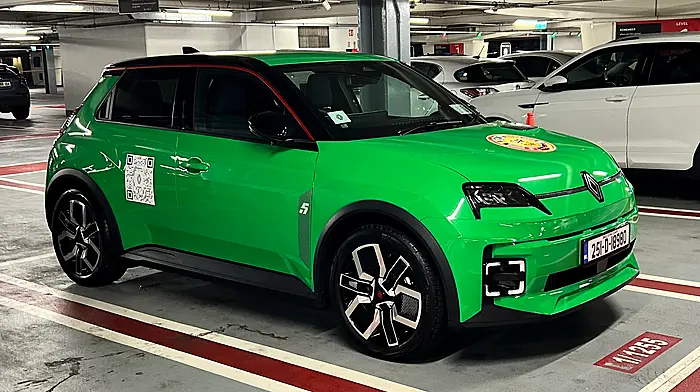BY TRISH WHELAN
TOYOTA’S Yaris Cross is a compact crossover SUV that is exclusively sold as a self-charging hybrid. It is also the brand’s smallest crossover.
Adding the B-segment Cross to the line-up gave Toyota an SUV range that spans the small, compact and medium-large segments while keeping the Yaris name for this new variant ensured it was regarded, and accepted, as an extension to the popular Yaris hatchback range. The brand says that both cars appeal to different types of customers.
While both cars are built on the same platform, and have the same 2,560mm wheelbase, the SUV is 240mm longer which allows for more interior space.
It is also 90mm taller and 20mm wider and has 30mm higher ground clearance. Larger wheels and tyres help give added impression to that all-important SUV look.
Grades are Luna, Luna Sport, Sol and Adventure. My car was in the top Adventure FWD grade with a pearl ice white exterior colour which showed off the car’s styling to perfection, contrasting with the black gloss pillars, big wheel arches and 18-inch dark grey alloy wheels, the black protection mouldings on the side doors, roof bars, and rear privacy glass. Black and white is always a classy look.
The added height makes this motor easier to get in and out of — tall people won’t have to duck their heads — and provides a higher driving position that many buyers look for, as well as improved visibility.


The interior is nicely styled but I felt could do with a bit of brightening up. Granted there are touches of bright like the chrome surrounds to the air con buttons, the gear shift knob and some light blue ambient lighting on front doors and in the centre console which all add interest.
Seats are comfy and supportive especially along your back. The front ones can be heated. As with many small SUVs, there’s not great rear legroom for an adult seated behind a six-footer up front, but the headroom here is absolutely fine. The felt door trim looked a bit smudged in places and I wondered if it would wear well.
The dash features a new standalone 9-inch touchscreen infotainment display (on my Adventure version) that is as good as most of its competition. All grades come with smartphone connectivity.
The 10-inch head up display meant I didn’t have to take my eyes off the road to check my current speed, which is also displayed digitally on the instrument panel. To the left you see the PWR, Eco, and ‘state of charge’ screen. In EV mode, electric power is supplied by the hybrid battery and only the electric motor is used to drive the car. This mode allows you drive quietly in residential areas early in the morning or late at night. The charge area shows the regeneration status. Regenerated energy, achieved mostly through slowing down and braking, is used to charge the hybrid battery. That’s why hybrids are very well suited to urban driving. Toyota claims you can drive in EV mode up to 62pc of the time and use up to 30pc less fuel than with an ICE vehicle.
The boot floor is another very practical feature as it can be split in two, providing more space and an underfloor storage area to keep items out of sight. With all seats up, and the tonneau cover in place, there is up to 397 litres of volume. There is a temporary spare wheel.

Other features included voice recognition, USB connector, a rear view camera, front and rear parking sensors, automatic braking and front LED-type fog lights. Toyota’s Safety Sense system is one of the best available with many active safety systems such as forward collision warning, intelligent adaptive cruise control and Hill-start control.
Power is from a 3-cylinder 1.5 116hp hybrid system, developed directly from the larger 2.0 and 2.5 powertrains used by Corolla, C-HR, RAV4 and Camry. The engine is matched to an e-CVT automatic transmission.
On the road, I found good feedback from the well-weighted steering, which helped my drive experience. The engine was nice and peppy with good acceleration. If pushed, it can achieve 0-100km/h in 11 seconds. Toyota claim a combined fuel return of around 4.5 to 5.0 L/100kms, but I clocked up 5.4 L/100kms (52 mpg) at the end of my test drive week which included a few long journeys to the midlands and back.
The AWD version features an electric system that weighs less than mechanical AWD units and so helps keep fuel consumption and C02 emissions down. In normal driving, the car operates with front-wheel drive which changes to all-wheel drive when low-trip conditions are detected, such as in heavy rain, on wet or packed snow or even on sand. Emissions for the FWD drive model start from below 90g/km C02, the AWD version from under 100g/km.
Toyota offers a standard three-year/100,000km mechanical warranty on all its vehicles and up to 10 years’ extended hybrid battery care on its hybrids.










